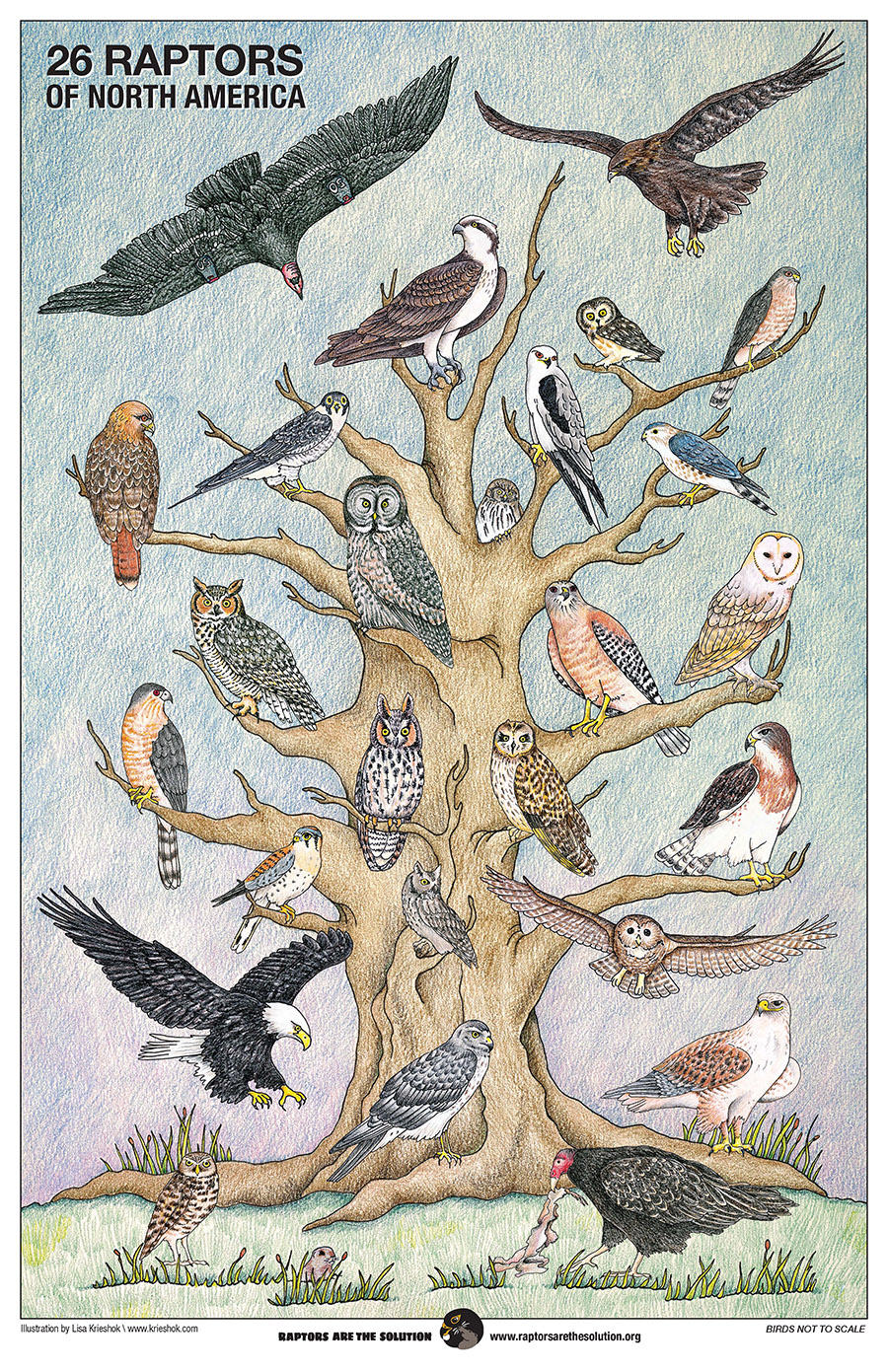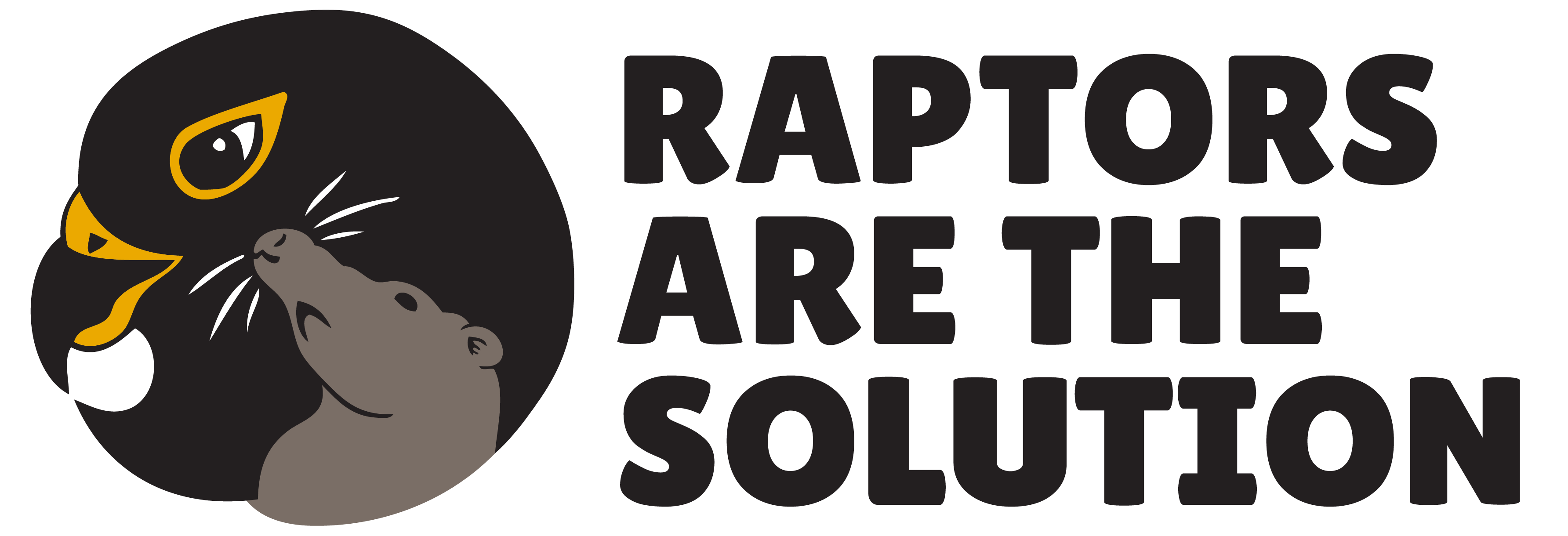Hover over each raptor for identification, then click for details.
(Click here for info on receiving your own 11×17 hard-copy poster!)
Raptors Identification

California Condor
1. California Condor (Gymnogyps californianus)
Habitat and range: Mountainous areas with cliffs or hollow trees for nesting. Extirpated in the wild in 1980s; reintroduced in central and southern California, northern Arizona, Baja California, and most recently Yurok tribal land in northern California.
Diet: Carrion.
Status: On US and California endangered species lists.
Threats: Lead poisoning from ammunition in land mammal carcasses, contaminants including DDT in marine mammal carcasses, trash ingestion, wildfire, shooting, potential rodenticide exposure.
Golden Eagle
10. Golden Eagle (Aquila chrysaetos)
Habitat and range: Mountains, hilly open country, and some forested areas from North America (mostly in West) across Eurasia; other populations in northern and eastern Africa.
Diet: Mainly rabbits and ground squirrels, sometimes grouse and pheasants; occasionally larger mammals and birds; carrion.
Status: Population stable.
Threats: Rodenticide poisoning, lead poisoning, wind turbine and powerline collisions, shooting.
Osprey
23. Osprey (Pandion haliaetus)
Habitat and range: Lakes, rivers, and seacoasts worldwide except Antarctica. Most northern 0spreys migrate south for winter.
Diet: Almost entirely fish, caught with grip-soled feet.
Status: Historically impacted by DDT and listed as endangered by several US states, but made dramatic comeback.
Threats: Other contaminants still a concern. Some small populations vulnerable. Migrants often shot at fish farms.
Red-tailed Hawk
Red-tailed Hawk (Buteo jamaicensis)
Habitat and range: Forests and open country from Alaska to Panama.
Diet: Rodents and other mammals, including bats; medium-sized birds; snakes.
Status: Population stable.
Threats: Rodenticide poisoning, wind turbine strikes, shooting.
Peregrine Falcon
Peregrine Falcon (Falco peregrinus)
Habitat and range: Wildlands (except deserts and rainforests) and many urban areas worldwide except Antarctica.
Diet: Mainly birds; bats in some areas. Females take larger prey than males.
Status: Recovered from near extirpation in North America due to DDT. Removed from US endangered species list 1999.
Threats: Collisions, insecticide poisoning.
White-tailed Kite
White-tailed Kite (Elanus leucurus)
Habitat and range: grasslands and savannahs from Oregon, California and US Gulf Coast to Argentina.
Diet: Rodents and other small mammals.
Status: North American populations rebounded from 20th-century low point.
Threats: Loss of nest trees and foraging areas. Rodenticide exposure documented for a closely related Asian species, the Black-winged Kite.
Northern Saw-whet Owl
Northern Saw-whet Owl (Aegolius acadicus)
Habitat and range: Dense coniferous forests from southern Alaska to southern Mexico.
Diet: Mice, other small rodents, and shrews: infrequently small birds, large insects, frogs.
Status: Some populations declining.
Threats: Habitat loss due to logging and, in southern Appalachians, climate change.
Sharp-shinned Hawk
Sharp-shinned Hawk (Accipiter striatus)
Habitat and range: Forests, mostly conifer, from Alaska to Central America. Also South America north and south of
Amazon region.
Diet: Almost entirely small birds; rarely small mammals
and lizards.
Status: Eastern population recovered from impacts of DDT and shooting, then apparently declined for unclear reasons.
Threats: Collisions, insecticide poisoning, potentially rodenticide exposure.
Merlin
Merlin (Falco columbarius)
Habitat and range: Boreal forests and prairies across Northern Hemisphere; winters south to South America, North Africa, and southern China.
Diet: Small and medium-sized birds, up to size of snipe; dragonflies and grasshoppers during migration.
Status: Most populations stable. Historically impacted by DDT.
Threats: Loss of nesting habitat.
The Merlin pictured is the light-colored “Prairie” subspecies, Falco columbarius richardsonii.
Northern Pygmy-Owl
Northern Pygmy-Owl (Glaucidium gnoma)
Habitat and range: Coniferous and mixed forests of western North America, from southeastern Alaska to northern Mexico.
Diet: Birds (up to size of quail, larger than the owl itself), small mammals, reptiles, frogs, insects.
Status: Some populations declining.
Threats: Habitat loss from logging, predation by Barred Owls.
Great Gray Owl
Great Gray Owl (Strix nebulosa)
Habitat and range: Boreal forests across Northern Hemisphere, south into Sierra Nevada and northern Rocky Mountains. Moves south in some winters.
Diet: Almost entirely voles; gophers in some areas; rarely birds.
Status: Declining in some northern states. Sierra Nevada subspecies state-listed as endangered.
Threats: Habitat loss, West Nile disease, climate change reducing prey base.
Great Horned Owl
Great Horned Owl (Bubo virginianus)
Habitat and range: Semi-open woodlands and some deserts from Alaska to Argentina and Chile; not in Amazon basin and other rainforests.
Diet: Primarily mammals (including skunks), medium-sized to large birds (including other owls), sometimes reptiles, frogs, large insects. Predominantly rats in some urban areas.
Status: Recent declines in northeastern US may be related to West Nile disease.
Threats: Rodenticide poisoning.
Cooper’s Hawk
Cooper’s Hawk (Accipiter cooperii)
Habitat and range: Nests in forests from southern Canada to Mexico. Northern birds winter south to Colombia. Has adapted to some urban areas.
Diet: Mostly small to medium-sized birds; also rats and other rodents (especially for juveniles?). Females take larger prey than males.
Status: Historically impacted by shooting and DDT, especially in eastern US, but populations have recovered.
Threats: Rodenticide poisoning, lead poisoning, other contaminants especially in urban settings.
Long-eared Owl
Long-eared Owl (Asio otus)
Habitat and range: Forests and other wooded areas of North America (south to northern Mexico), Eurasia, and northern Africa.
Diet: Mostly voles and other small mammals; rarely small and medium-sized birds.
Status: Declining in northeastern US and California. A California Species of Special Concern.
Threats: Habitat loss, nest predation. Susceptible to West Nile disease.
Short-eared Owl
Short-eared Owl (Asio flammeus)
Habitat and range: Northern population breeds in grasslands and tundra across Northern Hemisphere and migrates south; permanent resident in South America and many islands (West Indies, Hawaii, Galapagos).
Diet: Voles and other small open-country mammals; in Hawaii, birds and introduced rodents.
Status: Declining in northeastern US, California, and elsewhere. A California Species of Special Concern.
Threats: Loss and fragmentation of grassland habitat, nest predation.
Red-shouldered Hawk
Red-shouldered Hawk (Buteo lineatus)
Habitat and range: Riparian forests and moist woods of eastern US; an isolated population in California. Increasing in suburbs.
Diet: Small mammals, frogs, snakes; occasionally birds, crayfish, and insects.
Status: Population stable.
Threats: Loss and fragmentation of forest habitat, insecticide poisoning, ingestion of microplastics.
Barn Owl
Barn Owl (Tyto alba)
Habitat and range: worldwide except for Antarctica, mostly in open country; some populations in forests. In North America, from southern British Columbia and Great Lakes south. Often uses barns and other human-made structures.
Diet: Rats, voles, gophers, and other small rodents; rarely bats, birds, insects.
Status and Threats: Declining in northern part of North American range; listed in Canada and 23 US states. Also declining in Europe.
Threats: Rodenticide and insecticide poisoning, motor vehicle collisions, loss of foraging habitat (due to changes in farming practices) and nesting sites, severe winter weather.
Swainson’s Hawk
Swainson’s Hawk (Buteo swainsoni)
Habitat and range: North American plains from southern Canada to northern Mexico. Most migrate to Argentina; some winter as far north as California.
Diet: Mostly rabbits and rodents, occasionally small birds; more insects in non-breeding season.
Status: Has declined in Canada, California, and elsewhere.
Threats: Insecticide poisoning in Argentina, loss of breeding and wintering habitat due to changes in farming practices.
Northern Spotted Owl
Northern Spotted Owl (Strix occidentalis caurina)
Habitat and range: Mature conifer and mixed forests from southern British Columbia to central California; other subspecies in Sierra Nevada, southern Rocky Mountains, and Sierra Madre.
Diet: Small arboreal rodents like flying squirrels and tree voles, sometimes small birds.
Status: Federally listed as Threatened. Populations declining rapidly.
Threats: Loss of old-growth habitat, competition from and hybridization with Barred Owls, rodenticide poisoning (especially from illegal cannabis grows).
Western Screech-Owl
Western Screech-Owl (Megascops kennicottii)
Habitat and range: Woodlands, semi-desert, and suburban areas from southeastern Alaska to central Mexico.
Diet: Small mammals (including bats), birds, frogs, tadpoles, small fish, crayfish, earthworms.
Status: Declining in Canada.
Threats: Habitat loss, predation by Barred Owls, West Nile disease.
American Kestrel
American Kestrel (Falco sparverius)
Habitat and range: Open areas with short vegetation and
tree cavities for nesting, including parks and some cities. Breeding range from Alaska to Argentina and Chile, except for Amazon region.
Diet: Voles and other small mammals, large insects, small birds, lizards.
Status: Some North American populations declining.
Threats: Loss of habitat, including nest sites; rodenticide exposure.
Bald Eagle
Bald Eagle (Haliaeetus leucocephalus)
Habitat and range: Nests in forested areas, usually near water, from Alaska to northwestern Mexico and Florida; wider range
in winter.
Diet: Fish (often pirated from Ospreys), waterfowl, some mammals, carrion.
Status: Population stable. Recovered from impact of DDT. Removed from US Endangered Species status 2007.
Threats: Lead poisoning, rodenticide poisoning, collisions, shooting.
Northern Harrier
Northern Harrier (Circus hudsonius)
Habitat and range: Grasslands and marshes from Alaska to Baja California and Texas panhandle; winters south to Central America.
Diet: Voles and other small mammals, birds up to size of small ducks. More rodents in winter, more birds in coastal marshes.
Status: Declining in much of breeding range. A California Species of Special Concern.
Threats: Degradation of upland habitat through overgrazing and changing farming practices; loss of wetlands.
Ferruginous Hawk
Ferruginous Hawk (Buteo regalis)
Habitat and range: Grasslands and scrublands of western North America; winters south to Mexico.
Diet: Mainly rodents (ground squirrels, prairie dogs, gophers) and rabbits.
Status: Declining in Canada and elsewhere.
Threats: Habitat loss, rodenticide poisoning, shooting, wind turbine strikes, electrocution.
Turkey Vulture
Turkey Vulture (Cathartes aura)
Habitat and range: Forested and open country, southern Canada to Argentina and Chile. Some northern populations migratory.
Diet: Carrion, occasionally insects, rotting vegetation (pumpkins, coconuts).
Status: Populations stable.
Threats: Rodenticide, lead, and insecticide poisoning, motor vehicle collisions, shooting.
Burrowing Owl
Burrowing Owl (Athene cunicularia)
Habitat and range: Grasslands and deserts from western US to Argentina and Chile; isolated populations in Florida and West Indies. Northern populations migratory.
Diet: Insects and other arthropods, small mammals, occasionally small birds, reptiles and amphibians.
Status: Declining in Canada, Great Plains, California, Florida, and elsewhere. Listed as endangered in Canada and 15 US states. A California Species of Special Concern.
Threats: Habitat loss due to urbanization, changing farming practices, and extermination of burrowing rodents; also rodenticide and insecticide poisoning, wind turbine strikes, West Nile disease.
Gopher
Gopher
Food for many raptors.
